Gold crowns
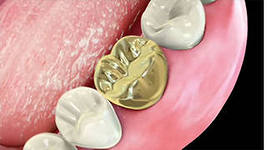
Despite the emergence of new technologies and the introduction of new types of non-metal ceramics into dental prosthetics, prosthetics with gold crowns is considered one of the best.
The metal has strength, durability, ductility and is therefore considered one of the reliable options for the manufacture of dental crowns. And the best metal for the production of dentures is gold.
Modern orthopedics can offer the installation of ceramic structures, but they are much inferior to gold dentures in terms of wear resistance.
In modern conditions, gold crowns are made only in state dental clinics. When working with precious metals, the clinic must have a license, which is very difficult to obtain.
Therefore, in dental offices, metal crowns are often made of alloys, which may include gold.
Gold crowns are most often placed on the lateral teeth, as they are not noticeable when smiling.
Making Gold Crowns
Gold crowns, depending on the manufacturing method, are stamped and cast.
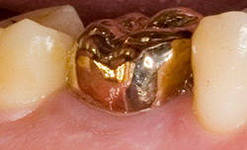
Stamped crowns are made from standard blanks - sleeves. They are finally adjusted in the oral cavity before being fixed to the dental cement mortar.
Cast gold crowns are made according to individual wax models. They do not require fitting in the oral cavity, as they are more accurate in manufacture.
Under crowns made by casting, when turning the tooth, a thicker layer of enamel is removed than under stamped ones.
The crown manufacturing process involves several steps.
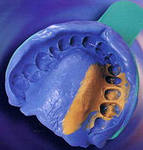
- Preparing a tooth for preparation (treatment of caries, replacing an old filling, restoring a tooth on a pin, etc.).
- Anesthesia for the upcoming preparation of the tooth.
- Tooth turning. The tooth is grinded on all sides by the thickness of the crown, which will be installed on the tooth. Grinding the tooth under the crown, the doctor not only reduces the size of the tooth, but also gives it a certain shape, making ledges in the cervical part of the tooth. The walls of the turned teeth should converge upward for easier donning of the crown on the tooth.
- Casting of the upper and lower jaws.
- Making a plaster model of teeth in a laboratory.
- On the model of wax, a prototype of an artificial crown is made.
- Trying a gold crown on a tooth and, if necessary, adjusting it.
- Fixing the crown with cement to the tooth.
Indications
The installation of gold crowns is necessary in some cases:
- If you want to restore the anatomical shape of the tooth.
- To restore tooth function.
- Reinforce teeth if necessary.
- In order to improve aesthetics.
- With a strong bite.
- If there are parafunctional habits: clenching your teeth, grinding your teeth.
- To restore chewing teeth.
Contraindications
The installation of gold crowns is contraindicated in the following cases:
- If the patient has not reached 16 years of age.
- The presence of chronic periodontitis.
- With mental illness.
- During pregnancy.
How is the installation
After the tooth is prepared (prepared) for the installation of a gold crown, a cast is made and sent to the dental laboratory.

- At the time of manufacture of the permanent design, a temporary crown is made to protect the honed tooth from decay and reduce the patient’s discomfort.
- Fitting and correction of the finished crown in the patient's oral cavity.
- The installation of a gold crown and fixation using special cement is done only after the doctor makes sure that the structure sits on the tooth perfectly: it does not interfere with the closure of the opposing teeth, tightly grasps the tooth.
Recovery and rehabilitation
After the dental crowns are installed, you can lead a normal lifestyle. It is allowed to eat and drink immediately if the doctor has not warned otherwise (this depends on the type of cement on which the crown was fixed).
The first days it is advisable to refrain from eating hard foods, because you can bite your tongue, cheek, lip.
After installing dental structures, problems may arise when using them:
- Discomfort, as well as increased tooth sensitivity. Sensitivity will begin to increase immediately after the termination of anesthesia. If the prosthesis did not depulpate during prosthetics, the tooth may be sensitive to cold or hot. In this case, the dentist will recommend brushing your teeth with special toothpaste for sensitive teeth.
- The feeling of pain when biting indicates that the tooth crown is set high. This problem is easily fixed.
- If the patient has parafunction of the chewing muscles, the doctor will make a night mouth guard.
- Flushing of cement from under the crown and its weakening may be noted. This creates favorable conditions for the development of infection under the crown and the further development of caries.
- Incorrect fit or de-alignment may result in crown loss.
Video: “Dental crowns in dentistry”
FAQ
Many patients do not know which type of dental crown is more preferable for them. This will help a specialist to figure it out. When choosing the type of crown, the wishes of the patient, the state of the oral cavity and teeth, on which the structures will be installed, are taken into account. Indications and contraindications to this or that type of dental crown, as well as the financial capabilities of the patient, are taken into account.
Questions most often asked by patients:
- Question: What types of dental crowns can contain gold?
Answer: Currently, in addition to a monolithic crown made of gold, crowns made of cermet are used, the frame of which can be made of gold.
- Question: What dentures are made using gold?
Answer: Metal and cermets. Fixed dental structures - implants - the crown is made of gold, and the implant is made of titanium. Bridges and crowns are also made of gold.
- Question: I want to put gold dental crowns. What sample of gold is required for their manufacture?
Answer: For the manufacture of dental prostheses, gold 900 is used.
Pros and cons
The advantages of gold crowns:
- When chewing, gold designs have almost no abrasive effect on opposing teeth. As a result, wear of teeth - antagonists is prevented.
- Gold has a beneficial effect on teeth and the body as a whole.
- Positive effect on the microflora of the oral cavity.
- Gold is inert to saliva and food components.
- Durability of dentures.
- Hypoallergenicity.
- Safety and harmlessness to the body.
- Teeth under crowns of gold break very rarely.
- Excellent withstand chewing load.
- Designs never chip or break.
Disadvantages of gold crowns:
- Fast abrasion of crowns, due to the softness of the metal.
- The high cost of gold designs.
- Lack of aesthetics on the front teeth.
Gold crowns care
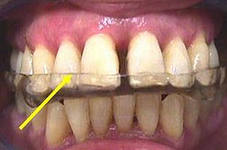
- Gold crown care requires routine oral hygiene. Teeth should be brushed twice a day with toothpaste and toothpaste and floss used to clean the interdental spaces. In this way, calculus can be prevented in places where the crown passes into the gum, gum disease and tooth decay.
- Do not chew solid food, bite nuts, seeds, ice, etc. solid objects.
- Do not bite your nails.
- Do not grit your teeth or grit them. If such a habit exists, then at night it is necessary to put on a protective device on the teeth. Such a device will help protect the crown of teeth during sleep.
Gold crowns prices
Gold crowns for teeth, the price of which is the cost of one gram of gold (65 euros per 1 g) and the cost of the work of a doctor and a dental technician, can be comparable to the price of expensive ceramic prostheses.
| Type of crown | Price (in rubles) |
| Gold crown for one tooth | From 10000 |
| Cermet crown (gold) | From 17000 |
| Zirconia single tooth design | From 13000 |
| Porcelain crown on front tooth | From 16000 |
Photos before and after installing gold crowns
 |
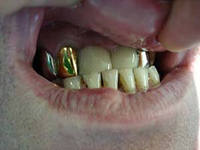 |
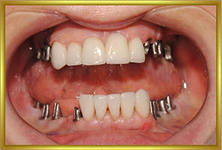 |
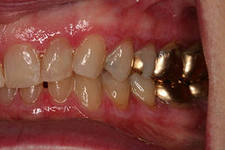 |
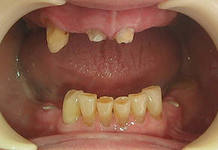 |
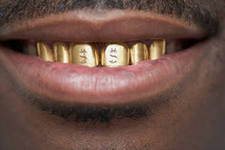 |
